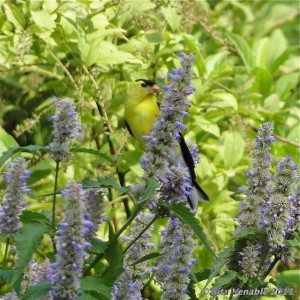
Plants that work and work well have a better chance of “making the cut” in our small garden. If a plant serves as both a hostplant for butterfly caterpillars and an attractive cut flower, it might be considered. If a plant is an herb, but also attracts butterflies for nectaring, it deserves some thought. If a tree, such as the Eastern redbud, provides seasonal color, acts as a hostplant, and provides nectar, it is in the top-tier of functional.
Agastache, which is in the mint family, (Laminaceae) works double duty. It provides both ample nectar for butterflies and lots of seed for goldfinches in mid to late summer. Giant and Eastern Tiger Swallowtails, Gulf Fritillaries, Monarchs, and Silver-spotted, Zabulon, and Fiery Skippers have all been seen nectaring on Agastache in our garden. Goldfinches, which nest from June—September, eat the seed and also feed their young on partly digested seed that is regurgitated into the mouths of the nestlings.
There are different cultivars of this perennial. I have tried both ‘Black Adder’ and ‘Raspberry Summer’, and both perform admirably. They bloom profusely in June, July, and August, with some blooms remaining into the fall. This plant needs good drainage and cannot tolerate wet soil. It prefers slightly basic over acid soil.
Although Agastache acts as an attractive three-foot backdrop for the garden, it can get leggy, so it might need to be staked in late summer. If you deadhead and remove old stalks, it will continue to bloom and grow new green shoots. It can be divided in the fall, so one plant will eventually grow into several.
Deer and rabbits do not feed on this plant, so it grows without hindrance in spring. It will spread some but not aggressively. Agastache has definitely “made the cut” in our garden!
©Rita Venable 2012
Note: Agastache should be available in local garden centers in the spring.